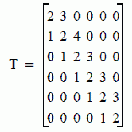







3.2 Defining Matrices
Once we understand vectors, the next most important abstraction in linear algebra is the concept of a linear mapping from one vector space to another. Since we are concerned only with vectors of finite dimension, such a mapping can always be represented using a matrix of coefficients. If x is a vector from one space, and y is a vector from another, we can represent a linear mapping from x to y as y=Ax, where A is a matrix, and Ax is an inner product. Often, the matrix A has some special structure; for example, it may be banded or symmetric.
The Linear Algebra Module has classes for many different matrix types. Each matrix type has a similar interface, so if you learn one, learning the others is easy. To give you a feel for using a matrix type, here is a simple example using a tridiagonal matrix class:
#include <rw/lapack/trdgmat.h> // 1
#include <iostream>
int main()
{
RWTriDiagMat<float> T(6,6); // 2
T.zero();
T.diagonal(0) = 2; // 3
T.diagonal(-1) = 1;
T.diagonal(1) = 3;
T(1,2) = 4; // 4
RWMathVec<float> x = " [ 2 3 9 8 3 0 ] ";
RWMathVec<float> Tx = product(T,x); // 5
std::cout << T << std::endl;
std::cout << x << std::endl;
std::cout << Tx << std::endl;
return 0;
}
|
| //1 | The first line declares the class RWTriDiagMat<float> as a new C++ type by including the Rogue Wave header file trdgmat.h. A variable of type RWTriDiagMat<float> represents a tridiagonal matrix of floating point numbers. A tridiagonal matrix is a matrix where all the entries are 0, except for the entries on the main diagonal, and the entries immediately above and below the main diagonal. |
| //2 | This line defines T to be an uninitialized 6 x 6 tridiagonal matrix; the next line sets all of its entries to 0. |
| //3 | Here we use the diagonal function to set the entire main diagonal to 2. The next two lines set the other two nonzero diagonals to 1 and 3. |
| //4 | In this line, we use subscripting to access a particular element of the matrix and change it. The matrix is set up as follows:
 |
| //5 | Here Tx is defined to be the matrix-vector inner product of T and x. It may seem confusing at first not to use the function operator* to do matrix-vector multiplication, but there is a good reason for doing things this way. The overloaded operators +, -, *, and / are all used to do element-by-element operations; this symmetry in the operators make it easier to remember the effects of the operators. |





Copyright © Rogue Wave Software, Inc. All Rights Reserved.
The Rogue Wave name and logo, and SourcePro, are registered trademarks of Rogue Wave Software. All other trademarks are the property of their respective owners.
Provide feedback to Rogue Wave about its documentation.

